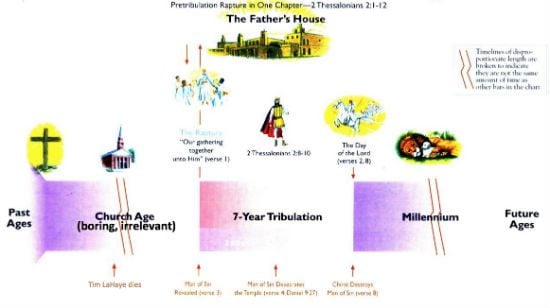I’m not accustomed to being in total agreement with something posted at the National Review Online, but I have to offer a hearty “Amen” to Carl E. Olson’s devastating dismissal of Glorious Appearing, the latest book in Tim LaHaye and Jerry Jenkins’ Left Behind series.
Olson is an orthodox Catholic and the author of Will Catholics Be Left Behind?: A Critique of the Rapture and Today’s Prophecy Preachers. (For a long list of Olson’s articles debunking apocalyptic Rapture-mania, see here.)
As such, he is offended by the strange 19th-century heresies that L&J peddle as biblical truth. And he’s just as offended — almost just as angry — with their aesthetic and literary sins:
… episode #12, titled Glorious Appearing, is underwhelming and pedestrian, poor qualities for a novel about a Big Event. …
Having read many of the other “Left Behind” books, I readily admit that I expected Glorious Appearing to be bloated, stilted, and corny. As it turns out, that combination would have been a welcome relief from the 400 pages of repetitive, numbing bombast that assaulted my weary eyes. …
This apparent cynicism isn’t a matter of theological triumphalism (I believe in the return of Jesus Christ) or literary snobbery. I’ve enjoyed books by Louis L’Amour, Robert Ludlum, and Wilbur Smith and have never mistaken them for literary giants, although they did have the commendable ability to tell a story, a talent not employed in the writing of Glorious Appearing. That is, unless you think a good story can consist of endless details about weaponry, vehicles, telecommunications, Palestinian geography, and premillennial dispensationalist theology, interrupted by the conversations of bland characters who elicit no sympathy whatsoever.
Olson also catches LaHaye in what is at best an arrogant delusion, at worst a lie. LaHaye told Pentecostal Evangel magazine that “Left Behind is the first fictional portrayal of events that are true to the literal interpretation of Bible prophecy.” LB’s premillennial dispensationalism is hardly based on an obvious or literal reading of the Bible, but let that pass for the moment. The problem here is that L&J’s books are merely the latest in a long line of PMD novels — novels from which L&J derived their basic template and borrowed many essential tropes.
I noted earlier how Buck Williams is plainly based on the journalist-protagonist Tom Hammond in Sydney Watson’s 1916 Rapture novel The Twinkling of an Eye. Olson notes that many of the details of LB are “remarkably similar” to Salem Kirban’s 666, a best-selling Rapture novel published in 1970 by Tyndale House — L&J’s publisher. (Olson explores these similarities in more detail in “Recycled Rapture.”)
As Olson writes, the LB series:
… weren’t the first Rapture novels, nor are they the last. Whether or not they are the most painful to read is still open for vigorous debate …
Many others have written scathing reviews of the newest book in L&J’s series, but what sets Olson’s review apart is that he rejects the authors’ claim that the theology informing their series is biblical, or even Christian:
First, the “left-behind” theology is not the “Christian” or the “biblical” view of the end times, despite what LaHaye says, or what the media sometimes echoes. Premillennial dispensationalism and the belief in a Rapture event separate from the Second Coming is rejected, either explicitly or implicitly, by the Catholic Church, the Eastern Orthodox churches, and nearly every major Protestant denomination. Dispensationalism, with its particular views about the nature of the Church and the role of Jews in end-times events, was created in the 1830s by former Anglican priest John Nelson Darby (1800-1882) and later systematized in the United States by C. I. Scofield (1843-1921) and Lewis Sperry Chafer (1871-1952). Hal Lindsey’s 1970 best-selling The Late Great Planet Earth took popular dispensationalism into secular culture, a feat repeated by the “Left Behind” series.
As Evangelical scholar and Wheaton College graduate Ronald M. Henzel has decisively shown in his book, Darby, Dualism, and the Decline of Dispensationalism, Darby built his entire theology on a radical dualism between heaven and earth that was unprecedented in the history of orthodox Christian thought.
A key phrase here is “despite … what the media sometimes echoes.” Olson puts his finger on what I find infuriating in the vast majority of coverage of the LB series. Naive and ignorant journalists (such as Morley Safer) simply take at face value L&J’s preposterous claim that they are presenting biblical, Christian theology. They’re not. And by repeating this claim, even otherwise critical reviews wind up bolstering LaHaye’s dubious authority as a “biblical scholar.”
I have no problem with people writing novels based upon their religious beliefs, no matter what those beliefs may be. Authors like L. Ron Hubbard or Ayn Rand had every right to promote their esoteric pseudoreligious claims in didactic novels. But authors do not have the right to pretend these views are something they are not. You can’t write a book about Scientology or objectivism and then claim that it’s actually based on Buddhism or Santeria. You can’t write a book about premillennial dispensationalism and then claim that it’s actually based on orthodox Christianity.
I’m not arguing for the persecution of heretics. I’m devoted to pluralism — let a million flowers bloom. But don’t write an Arminian novel and then tell me it represents strict Calvinism. Don’t write a Mennonite novel and then tell me it represents Roman Catholicism.
And don’t fecklessly fictionalize a 19th-century American mistake and tell me it represents “biblical Christianity.”












